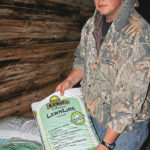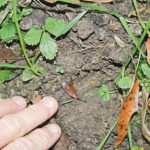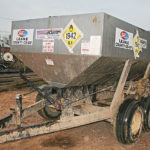
Now’s the time to bring soil samples to your county agent so you can use the right amount of lime to take the acidity out of your food plots.
“Does pH really matter?” Don Schmidt asked rhetorically as he began discussing this element of food-plot planting.
Schmidt is a retired county agent who now focuses his attention on his own food plots and property management. The obvious answer is yes.
For too long, pH has remained a mystery for many who strive to produce viable food plots for wildlife. Some have tried to circumvent this lack of knowledge by adding more fertilizer and hoping for the best. Others have simply ignored it and wondered later why the plots were less than productive.
Neither approach is logical. The correct thing to do is acquire an understanding of what pH is and how it impacts plots. After that, pH can be balanced and manipulated so that plots thrive.
What is pH? It is simply a measure of soil acidity or alkalinity. It is based on a scale ranging from 0 to 14, with 7 being neutral. Numbers lower than 7 indicate acidity; numbers greater than 7 indicate alkalinity. The natural measure of pH is determined by a variety of factors, such as how and where the soil was formed and the amount of rainfall the soil receives. This aspect is of little consequence in the scheme of managing pH, for it is the balancing of pH that must be done if the planter is to enjoy success.
How pH impacts plant growth is a rather complex procedure. Nutrients from fertilizer must be released and transferred to plants for them to grow as they should. Simply put, when pH is out of balance these nutrients tend to cling to the soil rather than spread to plant roots. No amount of fertilizer will rectify the situation if the pH has these nutrients locked in place. Conversely, proper pH will require less fertilizer to produce desirable results.
Schmidt notes that when he first began his work as a county agent, many of the farmers with whom he worked didn’t give attention to pH.
“They were underliming and overfertilizing,” he said. “But they have gotten better educated over the years.
“Food plots are no different than raising any other agricultural crop for high yield. You have to get the pH right.”
And what is the proper way to determine pH and manipulate it so that the crops produce? This is a step-by-step process.
The first thing to do is select the site and determine the crop to be planted. A soil test comes next. This procedure requires collecting soil from a specific area and sending it to a lab for analysis. The food-plot planter should contact a private lab, a university or visit a local county agent to get the details and boxes for collecting and shipping the soil. Specific questions will be asked regarding the sample, so be careful to provide all data needed.
The soil is then sent to the lab. Results and recommendations will be returned to the planter.
A few words of advice are in order here regarding soil tests and pH manipulation. Test results may require two or more weeks, perhaps longer. Additionally, altering pH can take up to three months. As a result, soil testing should be done well in advance of planting dates. If the planter waits too long, any altering of the pH will not be realized in the first planting. Another food-plot year will be wasted in poor production.
How the altering of pH is to be accomplished is dependent upon the results of the soil test. If pH needs to be increased on a specific plot for a specific plant, the addition of lime is the standard remedy. The amount of lime to be applied per acre will be spelled out in the test results. Follow this recommendation meticulously.
Lime is available in several forms, but powdered and pelletized are perhaps most common. Both work well; however, there are differences in application. With each, maximum contact with the soil is needed. Because of this, lime should be incorporated into the soil at the time of application. Disking will accomplish this. Even then, however, lime will have little impact on the soil if that soil is dry. Moisture is essential for the lime to react to the soil and begin balancing the pH. It is a good idea if possible to apply/incorporate lime ahead of a rain.
Finely-ground lime (powdered) works faster than the pelletized product. If the application of this is feasible, it is a good choice. Powdered lime is available in bulk at farm supply businesses, and is generally far less expensive than other types. But it can be difficult to apply. The best method is to take advantage of equipment such as lime trucks often offered by establishments that sell lime. If the plots can be reached by this equipment, powdered lime can be applied with little effort. If, on the other hand, the plots are remote and access to them is limited, smaller equipment such as that attached to an ATV or small tractor may be needed. Powdered lime has the potential of clogging these spreaders and can become problematic. One answer to this is switching to pelletized lime.
The pelletized version usually flows smoothly through any small spreader, such as the type used on an ATV. Even hand spreaders can be employed in truly out-of-the-way plots that can’t be worked with anything larger. This, however, is quite labor intensive. And keep in mind that pelletized lime is not as fast-acting as pulverized lime. Also, be advised that the amount suggested per acre after the soil has been tested remains the same, whether the lime is powdered or pelletized.
Occasionally there is need to decrease rather than increase pH, this depending a great deal upon the plant selected. When that need arises, two materials are commonly used: aluminum sulfate and sulfur. Aluminum sulfate changes soil pH immediately. Sulfur, however, requires quite a bit of time, this determined by the fineness of the sulfur, soil moisture, soil temperature and the presence of bacteria. The conversion instigated by the sulfur can take several months. As a result, most planters opt for aluminum sulfate when decreasing pH is required.
Other than the factors we have dealt with already, a common question regarding altering pH is how often it should be done. To answer that, go back to the soil-testing regimen. A test should be performed every year. This keeps the planter advised of the needs of the plots. If the pH is terribly out of balance, applications may be needed for several subsequent years.
Once the pH has been balanced, applications may not be needed except every other year or less often. If the test indicates two tons of lime per acre for example, there is no need to put four tons in an effort to more quickly rectify the situation or avoid future applications. Some of the additional lime will likely be lost to washing before it has an impact on the soil. Annual applications are the only logical approach.
“The maximum amount is two tons per acre per year, and let it incorporate into the soil,” Schmidt says. “What I do on my place is put out the amount of pelletized lime I can afford. Over the years, I will get the pH up.”
It is difficult to impossible to stockpile in hopes of avoiding future applications.
What may at first appear a great mystery to the uninitiated is not a mystery at all. For food plots to be all they can be, pH must be balanced as per the crop being planted. The difference between a plot growing in soil that has a pH value suitable to that particular crop and one that is in soil with a pH not suitable to that particular crop is dramatic. A simple visual inspection will show the benefits of proper pH. The plants will be lush, healthy and the animals will relish them rather than drop by for an occasional nibble. There simply is no substitute for the effort required in getting pH in balance.
So, does pH really matter? Without question it does. It must not be overlooked by the food-plot planter who wants the most from those plots.






